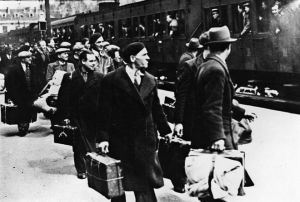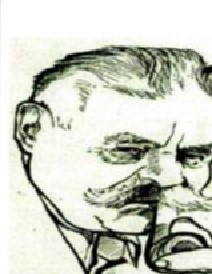Further to my previous posts on ‘ghost signs’ on various walls in the Touraine, the BBC has just posted an interesting article on the subject:
http://www.bbc.co.uk/news/magazine-37871550
My previous posts can be found at:

Further to my previous posts on ‘ghost signs’ on various walls in the Touraine, the BBC has just posted an interesting article on the subject:
My previous posts can be found at:
 Further to the problems of flooding in Central France over the past few weeks. My previous blogs on flooding in the Loire Basin have had an unusual number of daily hits!
Further to the problems of flooding in Central France over the past few weeks. My previous blogs on flooding in the Loire Basin have had an unusual number of daily hits!
If you’ve been effected then you might want to visit:
Tours bridge keeps falling down, falling down, falling down!
Other websites of possible interest:
 Today, France is finally opening up police and ministerial archives from the Vichy regime which collaborated with Nazi occupation forces in World War Two. More than 200,000 declassified documents are being made public. They date from the 1940-1944 regime of Marshal Philippe Petain.
Today, France is finally opening up police and ministerial archives from the Vichy regime which collaborated with Nazi occupation forces in World War Two. More than 200,000 declassified documents are being made public. They date from the 1940-1944 regime of Marshal Philippe Petain.
Amongst other issues, the documents should shed light on the deportation of some 76,000 Jews to Germany by officials of the regime (see image above) – and will be of interest to those in the Touraine region which straddled the Demarcation line.
Also visit: http://www.bbc.com/news/world-europe-35188755
 This portrait of Marcel Marceau, using oils on concrete, is by Francine Mayran. She painted it in order to “transmit his courage against the devil, and his humanity which stayed stronger than Nazi barbarism”. It is part of a series, “witnessing these lives – témoigner de ces vies ” where she attempts to transmit the humanity of victims by recalling that behind the numbers of victims of barbarism there were women, men and children all with their own identity and individuality.
This portrait of Marcel Marceau, using oils on concrete, is by Francine Mayran. She painted it in order to “transmit his courage against the devil, and his humanity which stayed stronger than Nazi barbarism”. It is part of a series, “witnessing these lives – témoigner de ces vies ” where she attempts to transmit the humanity of victims by recalling that behind the numbers of victims of barbarism there were women, men and children all with their own identity and individuality.
Francine’s paintings will be exhibited for the Remembrance of the Holocaust and of other Genocides of the XXth century. The next stop for this exhibition will be in Duisbourg (Germany) and then in the Château des Rohan, Saverne (France) . You can see further examples of her work @ www.fmayran.com

Bip the Clown ~ 1974
Marcel Marceau’s extraordinary talent for pantomime entertained audiences around the world for over sixty years but did you know that it also saved hundreds of Jewish children during the Holocaust.
Born to a Jewish family in Strasbourg, France in 1923, young Marcel Mangel discovered Charlie Chaplin at age five and became an avid fan. He entertained his friends with Chaplin imitations, and dreamed of starring in silent movies.
When Marcel was 16, the Nazis marched into France, and the Jews of Strasbourg – near the German border – had to flee for their lives. Marcel changed his last name to Marceau to avoid being identified as Jewish, and joined the French resistance movement.
Masquerading as a boy scout, Marcel evacuated a Jewish orphanage in eastern France. He told the children he was taking them on a vacation in the Alps, and led them to safety in Switzerland. Marcel made the perilous journey three times, saving hundreds of Jewish orphans.
He was able to avoid detection by entertaining the children with silent pantomime.
Documentary filmmaker Phillipe Mora, whose father fought alongside Marcel in the French resistance, said, ”Marceau started miming to keep children quiet as they were escaping. It had nothing to do with show business. He was miming for his life.’’
Marcel’s father perished at Auschwitz. Marcel later said, “The people who came back from the camps were never able to talk about it. My name is Mangel. I am Jewish. Perhaps that, unconsciously, contributed towards my choice of silence.”
While fighting with the French resistance, Marcel ran into a unit of German soldiers. Thinking fast, he mimicked the advance of a large French force, and the German soldiers retreated.
Word spread throughout the Allied forces of Marcel’s remarkable talent as a mime. In his first major performance, Marcel entertained 3,000 US troops after the liberation of Paris in August 1944. Later in life, he expressed great pride that his first review was in the US Army newspaper, Stars and Stripes.
In 1947, Marcel created his beloved character Bip, a childlike everyman with a stovepipe hat and a red carnation. For the next six decades, Marcel was the world’s foremost master of the art of silence. He was made “Grand Officier de la Légion d’Honneur” (1998) and was awarded the National Order of Merit (1998) in France. He won an Emmy Award for his work on television, was elected member of the Academy of Fine Arts in Berlin, was declared a “National treasure” in Japan, and Michael Jackson credited Marcel with inspiring his famous moonwalk.
In 2001, Marcel was awarded the Wallenberg Medal for his acts of courage during the Holocaust. When the award was announced, people speculated on whether Marcel would give an acceptance speech. He replied, “Never get a mime talking, because he won’t stop.”
Until his death at age 84, Marcel performed 300 times a year and taught 4 hours a day at his pantomime school in Paris. He died on Yom Kippur, 2007.
For risking his life to save orphans, and entertaining generations of fans without uttering a word, we honor Marcel Marceau.
Here’s a fascinating photo of the liberation celebrations of Descartes in on a sunny autumn day in September 1944.
The population of Descartes at the time was about 1,500 and it seems that up to a half of them were in the town square to celebrate.
The resistance against Nazi occupation was well organised in the district as the Conte-Freslon and, among other actions, on 31st August 1944 the Forces Françaises de l’Intérieur (F.F.I.) blew up the town’s bridge, Pont Henri IV, on the Vienne/Buxeuill side of the Creuse. Naturally, the local resistance fighters were represented in the Liberation celebrations and you can see that they are still operational and carrying their weapons.
See also my following posts:
Hi all, Quite some time back I posted a blog about old signage in the Touraine region. You may be interested in visiting Poitou-Charentes In Photos where the author gives some insights into the history of these ‘ghost signs’; see example below, Happy surfing, Jim
Gaston René Léon Monmousseau was born in Luynes on 17th January 1883. He was the son of John and Mary Silvine Monmousseau.
Gaston spent his childhood in Azay-sur-Cher. After leaving school he was apprenticed to a carpenter from Luynes.
After military service, he worked for the state railway in Paris where, as an anarcho-syndicalist, he campaigned amongst the railway workers. In January 1913, he organised an anti-militarist rally in Azay-sur-Cher against “the law of three years” (1). In 1917 Gaston was greatly inspired by the Russian October Revolution. By April 1920, he was Secretary of Propaganda for the Fédération des Cheminots (Federation of Railway Workers), he was arrested for plotting against the state. He was released in February 1921. One wonders if he was present at the 18th Congress of the French United Socialist Party held in Tours on 25 December 1920. See my previous blog entry.
As a member of the anarcho-syndicalist minority of the CGT, Gaston Monmousseau became secretary general of the CGTU, a position he held until 1933.
In December 1922, he represented the CGTU at the International Trade Union Congress in Moscow. In January 1923, having participated in the International Congress, “Imperialism and War”, he organised against the occupation of the Ruhr by French troops, he was imprisoned once again. Monmousseau also participated in the Congress of the Red Trade Union International in Moscow where he met Lenin.
 Turning away from anarcho-syndicalism, he joined the Communist Party in 1925 and became a member of the Central Committee and the Politburo. He was again imprisoned in 1927 following his involvement in the series of strikes directed against the Spanish-French colonialist war in northern Morocco (1920-26). Upon his release from jail, he married Alice Louise Marcelle Legendre at Courçay in the Touraine. Alice was the daughter of a peasant militant anarchist in the region.
Turning away from anarcho-syndicalism, he joined the Communist Party in 1925 and became a member of the Central Committee and the Politburo. He was again imprisoned in 1927 following his involvement in the series of strikes directed against the Spanish-French colonialist war in northern Morocco (1920-26). Upon his release from jail, he married Alice Louise Marcelle Legendre at Courçay in the Touraine. Alice was the daughter of a peasant militant anarchist in the region.
In September 1929, as Deputy-member of the Executive Committee of the Comintern (Communist International), he was charged with conspiracy against state security and released in May 1930. In April 1931, he was again imprisoned for 4 months. The April 26, 1936, Monmousseau was elected, on the first ballot (with 17,527 votes out of 31,255) to the Chamber of Deputies to the National Assembly for St. Denis, Paris (1936 was the year of the General Strike in France – a strike that was betrayed by the French Communist Party under direction from Stalin and Co in Moscow. Maurice Thorez, national secretary of the French Communist Party, stated that “one must know how to finish a strike, at the moment that the main points have been obtained.” Thus, the opportunity for strengthening opposition and resistance to European fascism, internal fascists, royalists, Petinists and the like was lost.). At the outbreak of World War II in 1939, and after the dissolution of the French Communist Party, Monmousseau went underground. Convicted in absentia, it is stripped of his parliamentary mandate. His only son died in deportation in Dachau.
I have found no information as to Monmousseau’s role in the French Resistance during World War II. But I imagine he played an active part. By summer 1941 (and the invasion of the Soviet Union) the French Communist Party’s ambiguous position towards resistance changed, and along with propaganda work among the occupation troops, armed struggle became the order of the day. See my previous blog entry.
From 1956 to 1960 he was a member of the Central Committee of the Communist Party. He died July 11, 1960 in the 19th arrondissement, Paris.